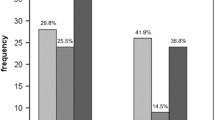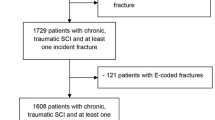Abstract
Summary
Osteoporosis is a well acknowledged complication of spinal cord injury. We report that motor complete spinal cord injury and post-injury alcohol consumption are risk factors for hospitalization for fracture treatment. The clinical assessment did not include osteoporosis diagnosis and treatment considerations, indicating a need for improved clinical protocols.
Introduction
Treatment of osteoporotic long bone fractures often results in lengthy hospitalizations for individuals with spinal cord injury. Clinical features and factors that contribute to hospitalization risk have not previously been described.
Methods
Three hundred and fifteen veterans ≥ 1 year after spinal cord injury completed a health questionnaire and underwent clinical exam at study entry. Multivariate Cox regression accounting for repeated events was used to assess longitudinal predictors of fracture-related hospitalizations in Veterans Affairs Medical Centers 1996–2003.
Results
One thousand four hundred and eighty-seven hospital admissions occurred among 315 participants, and 39 hospitalizations (2.6%) were for fracture treatment. Median length of stay was 35 days. Fracture-related complications occurred in 53%. Independent risk factors for admission were motor complete versus motor incomplete spinal cord injury (hazard ratio = 3.73, 95% CI = 1.46–10.50). There was a significant linear trend in risk with greater alcohol consumption after injury. Record review indicated that evaluation for osteoporosis was not obtained during these admissions.
Conclusions
Assessed prospectively, hospitalization in Veterans Affairs Medical Centers for low-impact fractures is more common in motor complete spinal cord injury and is associated with greater alcohol use after injury. Osteoporosis diagnosis and treatment considerations were not part of a clinical assessment, indicating the need for improved protocols that might prevent low-impact fractures and related admissions.
Similar content being viewed by others
References
Kanis JA (2002) Diagnosis of osteoporosis and assessment of fracture risk. Lancet 359(9321):1929–1936 June 1
Dauty M, Perrouin VB, Maugars Y, Dubois C, Mathe JF (2000) Supralesional anmesional bone mineral density in spinal cord-injured patients. Bone 27(2):305–309 August
Frey-Rindova P, de Bruin ED, Stussi E, Dambacher MA, Dietz V (2000) Bone mineral density in upper and lower extremities during 12 months after spinal cord injury measured by peripheral quantitative computed tomography. Spinal Cord 38(1):26–32 January
Garland DE, Stewart CA, Adkins RH, Hu SS, Rosen C, Liotta FJ, Weinstein DA (1992) Osteoporosis after spinal cord injury. J Orthop Res 10(3):371–378 May
Barrett-Connor E (1995) The economic and human costs of osteoporotic fracture. Am J Med 98(2A):3S–8S February 27
Bass E, French DD, Bradham DD, Rubenstein LZ (2007) Risk-adjusted mortality rates of elderly veterans with hip fractures. Ann Epidemiol 17(7):514–519 July
Chrischilles E, Shireman T, Wallace R (1994) Costs and health effects of osteoporotic fractures. Bone 15(4):377–386 July
Jain NB, Brown R, Tun CG, Gagnon D, Garshick E (2006) Determinants of forced expiratory volume in 1 second (FEV1), forced vital capacity (FVC), and FEV1/FVC in chronic spinal cord injury. Arch Phys Med Rehabil 87(10):1327–1333 October
Garshick E, Kelley A, Cohen SA, Garrison A, Tun CG, Gagnon D, Brown R (2005) A prospective assessment of mortality in chronic spinal cord injury. Spinal Cord 43(7):408–416 July
Ferris BG (1978) Epidemiology Standardization Project (American Thoracic Society). Am Rev Respir Dis 118(6 Pt 2):1–120 December
Marino RJ, Barros T, Biering-Sorensen F, Burns SP, Donovan WH, Graves DE, Haak M, Hudson LM, Priebe MM (2003) International standards for neurological classification of spinal cord injury. J Spinal Cord Med 26(Suppl 1):S50–S56
Simonelli C, Chen YT, Morancey J, Lewis AF, Abbott TA (2003) Evaluation and management of osteoporosis following hospitalization for low-impact fracture. J Gen Intern Med 18(1):17–22 January
Dawson DA (2003) Methodological issues in measuring alcohol use. Alcohol Res Health 27(1):18–29
Garshick E, Segal MR, Worobec TG, Salekin CM, Miller MJ (1989) Alcohol consumption and chronic obstructive pulmonary disease. Am Rev Respir Dis 140(2):373–378 August
Garland DE, Adkins RH, Kushwaha V, Stewart C (2004) Risk factors for osteoporosis at the knee in the spinal cord injury population. J Spinal Cord Med 27(3):202–206
Kogawa M, Wada S (2005) Osteoporosis and alcohol intake. Clin Calcium 15(1):102–105 January
Mukamal KJ, Robbins JA, Cauley JA, Kern LM, Siscovick DS (2007) Alcohol consumption, bone density, and hip fracture among older adults: the cardiovascular health study. Osteoporos Int 18(5):593–602 May
Newcombe RG, Clements DG, Evans WD (1993) Alcohol and bone density. BMJ 307(6899):323 July 31
Sampson HW, Chaffin C, Lange J, DeFee B (1997) Alcohol consumption by young actively growing rats: a histomorphometric study of cancellous bone. Alcohol Clin Exp Res 21(2):352–359 April
Saville PD, Lieber CS (1965) Effect of alcohol on growth, bone density and muscle magnesium in the rat. J Nutr 87(4):477–484 December
Schapira D (1990) Alcohol abuse and osteoporosis. Semin Arthritis Rheum 19(6):371–376 June
Wosje KS, Kalkwarf HJ (2007) Bone density in relation to alcohol intake among men and women in the United States. Osteoporos Int 18(3):391–400 March
Ducy P, Amling M, Takeda S, Priemel M, Schilling AF, Beil FT, Shen J, Vinson C, Rueger JM, Karsenty G (2000) Leptin inhibits bone formation through a hypothalamic relay: a central control of bone mass. Cell 100(2):197–207 January 21
Karsenty G (2006) Convergence between bone and energy homeostases: leptin regulation of bone mass. Cell Metab 4(5):341–348 November
Bauman WA, Spungen AM, Wang J, Pierson RN Jr, Schwartz E (1999) Continuous loss of bone during chronic immobilization: a monozygotic twin study. Osteoporos Int 10(2):123–127
Eser P, Frotzler A, Zehnder Y, Schiessl H, Denoth J (2005) Assessment of anthropometric, systemic, and lifestyle factors influencing bone status in the legs of spinal cord injured individuals. Osteoporos Int 16(1):26–34 January
Zehnder Y, Luthi M, Michel D, Knecht H, Perrelet R, Neto I, Kraenzlin M, Zach G, Lippuner K (2004) Long-term changes in bone metabolism, bone mineral density, quantitative ultrasound parameters, and fracture incidence after spinal cord injury: a cross-sectional observational study in 100 paraplegic men. Osteoporos Int 15(3):180–189 March
Stiens SA, Kirshblum SC, Groah SL, McKinley WO, Gittler MS (2002) Spinal cord injury medicine. 4. Optimal participation in life after spinal cord injury: physical, psychosocial, and economic reintegration into the environment. Arch Phys Med Rehabil 83(3 Suppl 1):S72–S78 March
Gilchrist NL, Frampton CM, Acland RH, Nicholls MG, March RL, Maguire P, Heard A, Reilly P, Marshall K (2007) Alendronate prevents bone loss in patients with acute spinal cord injury: a randomized, double-blind, placebo-controlled study. J Clin Endocrinol Metab 92(4):1385–1390 April
Mechanick JI, Liu K, Nierman DM, Stein A (2006) Effect of a convenient single 90-mg pamidronate dose on biochemical markers of bone metabolism in patients with acute spinal cord injury. J Spinal Cord Med 29(4):406–412
Shapiro J, Smith B, Beck T, Ballard P, Dapthary M, BrintzenhofeSzoc K, Caminis J (2007) Treatment with zoledronic acid ameliorates negative geometric changes in the proximal femur following acute spinal cord injury. Calcif Tissue Int 80(5):316–322 May
Zehnder Y, Risi S, Michel D, Knecht H, Perrelet R, Kraenzlin M, Zach GA, Lippuner K (2004) Prevention of bone loss in paraplegics over 2 years with alendronate. J Bone Miner Res 19(7):1067–1074 July
Del Boca FK, Darkes J (2003) The validity of self-reports of alcohol consumption: state of the science and challenges for research. Addiction 98(Suppl 2):1–12 December
Morse L, Teng YD, Pham L, Newton K, Yu D, Liao WL, Kohler T, Muller R, Graves D, Stashenko P, Battaglino R (2008) Spinal cord injury causes rapid osteoclastic resorption and growth plate abnormalities in growing rats (SCI-induced bone loss in growing rats). Osteoporos Int 19(5):645–652 May
Morse LR, Nguyen HP, Jain N, Williams S, Tun CG, Battaglino RA, Stashenko P, Garshick E (2008) Age and motor score predict osteoprotegerin level in chronic spinal cord injury. J Musculoskelet Neuronal Interact 8(1):50–57 January
Bauman WA, Zhong YG, Schwartz E (1995) Vitamin D deficiency in veterans with chronic spinal cord injury. Metabolism 44(12):1612–1616 December
Acknowledgments
We wish to acknowledge Joda Alian for her kind assistance in manuscript editing and preparation.
Conflicts of interest
None.
Disclaimers
The project reported/outlined here was supported by the Office of Research and Development, Health Services R&D Service, Quality Enhancement Research Initiative RRP-07–312 and NIH/NICHD RO1 HD42141 (Dr. Garshick). Dr. Garshick is the Associate Chief of Pulmonary and Critical Care Medicine at VA Boston Healthcare System. The views expressed in this article are those of the authors and do not necessarily represent the views of the Department of Veterans Affairs.
Author information
Authors and Affiliations
Corresponding author
Rights and permissions
About this article
Cite this article
Morse, L.R., Battaglino, R.A., Stolzmann, K.L. et al. Osteoporotic fractures and hospitalization risk in chronic spinal cord injury. Osteoporos Int 20, 385–392 (2009). https://doi.org/10.1007/s00198-008-0671-6
Received:
Accepted:
Published:
Issue Date:
DOI: https://doi.org/10.1007/s00198-008-0671-6




